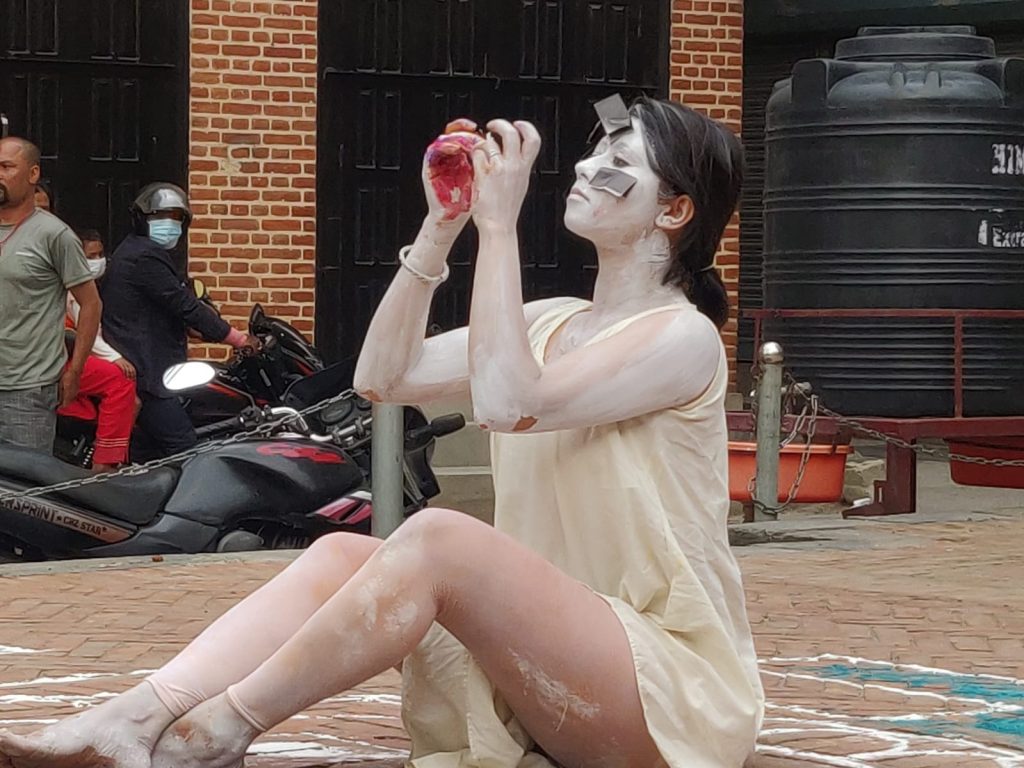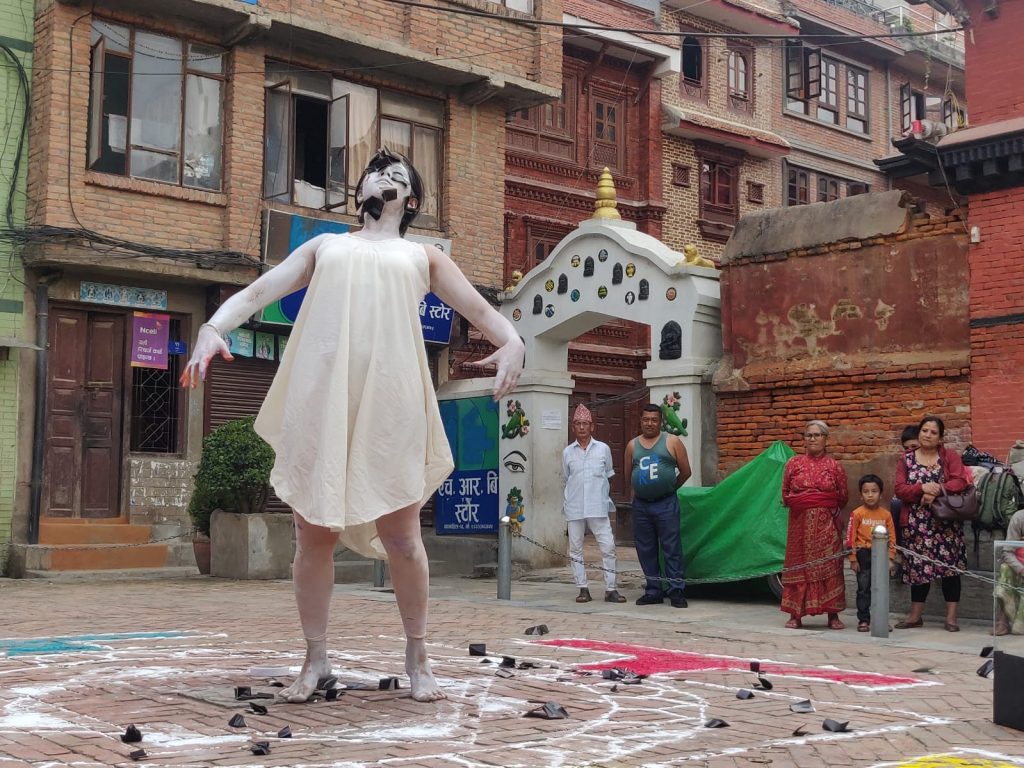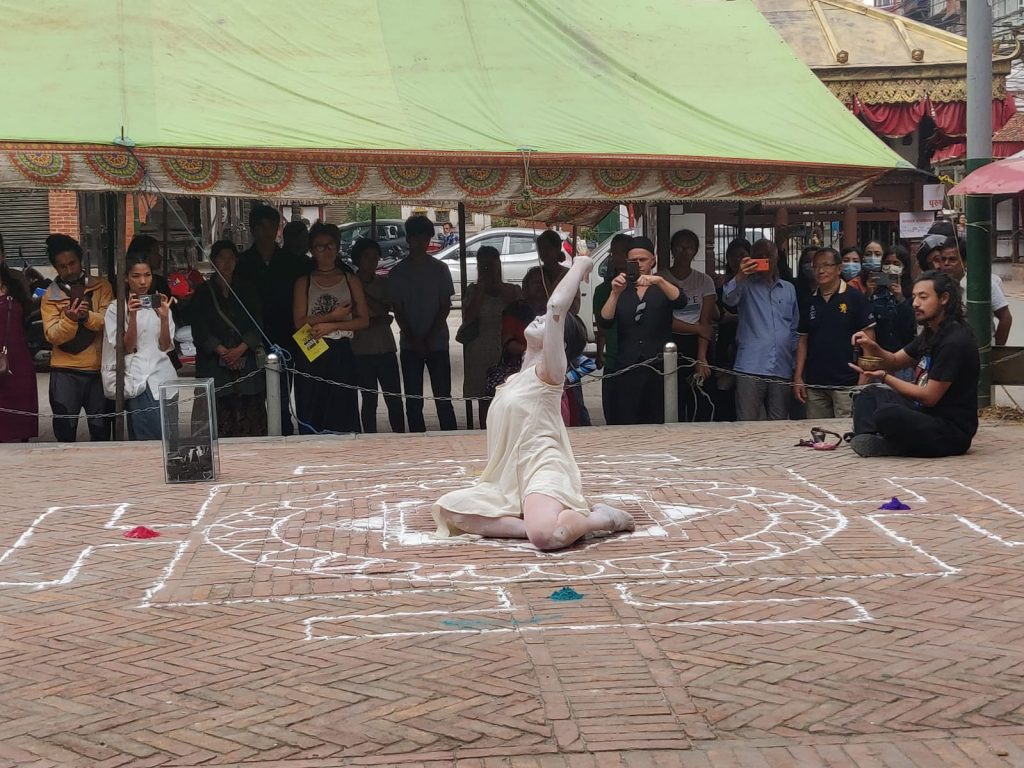Is life beautiful? If yes, what makes life beautiful? Can people make their lives beautiful? If so, how? In her quest to answer all these questions, Mahima Singh stepped into a courtyard at Naka Bahi of Lalitpur on Saturday.
Clad in white, and with her face painted white too, Mahima Singh stepped into the courtyard with slow and delicate movements. Throughout her performance, she continued her slow movements, inspired by the butoh dance, taking stances to show the different phases of her emotions. Further, through her performance, she answers what life is and how one can make it beautiful.
Finding answer

Finding peace and making one’s life beautiful has been a constant struggle among people. Mahima Singh was also one of them and she shares she was constantly arguing with herself about the meaning of life and the meaning of having desires in life.
“As a student of (applied) Buddhism, for the longest time, I heard teachers saying that life is beautiful and it should be free of wants and desires. But, I never connected to that philosophy. Though I understood the concept, I always used to question what is the point of a life without desires. So, I struggled with that for a long time.”
However, for Mahima Singh, Yongey Mingyur Rinpoche and his words came to the rescue. “In his speech and teaching, he said life is like a sky and it is or can be both clear and messy. He mentioned that the sky is our lives and the clouds are our desires and longings. As the clouds increase, the sky becomes dark but when we clear them out, we can see that the sky (life) is beautiful. However, having desires does not change the nature of the sky.”
So, she says her question–if life is beautiful, how people can take their desires out of their life–was answered by Rinpoche. “He says we can do that with meditation and gaining knowledge on how one can attain that peace.”
And in her performance for the ongoing exhibition Revisiting the Roots in a modern nuance on Saturday, Mahima Singh explores the same that incorporates butoh dance.
Why butoh?

After knowing Rinpoche’s words, Mahima Singh came to know about the butoh dance from the internet. Butoh is an expressive way of expression that originated in Japan and is common for expressing one’s journey, pain and untapped emotions towards the point where one gets a clear mind. The dance is heavily inspired by people’s daily lives.
The identity crisis, the concept of mindfulness and living a content life can be something to express with the butoh dance.
The dance does not have specific movements or meanings behind it. There are also no steps or routines; it just focuses more on bodily movements. But, it can be choreographed by the artist, she adds.
So why choose the dance? “In other dances, artists show their strength whereas, in the butoh, one can show their weakness. Anyone can do the dance to express themselves. So it fit the theme of the performance.”
Her own definition

Bringing both the concepts, Mahima Singh put together the performance to make people aware of what she learned about life. “People have to realise that having desires is not wrong, but it is our desires that are an unwanted mess.”
For her performance, Mahima Singh had set a mandala filled with five colours representing five feelings, five elements of life and five stages of meditation. The concept draws a heavy influence from eastern or Buddhist philosophy.
Mahima Singh put together a participatory art, in which she asked people to come and write their desires (one that got fulfilled, one that did not and one that is yet to be fulfilled) and collect them on a black paper, in a box. One by one, she put them on the mandala as well as taped their desires onto her own body that is white, representing innocence and purity, as guided by the butoh dance.
“Sticking the wishes written on black paper on a white body represents how our desires corrupt us,” she explains.
To show this, she takes out the same black papers stuck on her body reflecting that once you get rid of the desires, one can back to their innocent and peaceful self.
The dance is spiritually awakening and slow in terms of bodily movement. Singh’s performance was coupled with the humming sounds and music/vibration from a singing bowl played by Ryan Rajbhandari that complemented it.
Artist’s dilemma

Mahima Singh identifies herself as a performance and installation artist. She started doing performance art in 2007. She usually picks performances that demand social and human participation. “Just like how life is incomplete without people, my performances are a depiction of the theory that art also is the same.”
Her subjects generally revolve around socio-political events and make it a general commentary on the city’s environment and art, social occurrences, and social critique. She focuses more on feelings and experiences of living life in Kathmandu.
For Mahima Singh, performance art is her way of expressing herself. “A picture might say a thousand words, but performance art is more expressive. When you are aware of issues and you have art as your skill, you have to use them together to make people aware and create more civilised citizens and a cultured society. It is my way to share what I learned.”
However, it saddens her that performance art is easily mixed up with street drama. “Maybe because it is becoming more prominent in new forms of activism such as flash mobs and silent protests. Nowadays many who talk about art are directly linking it to the economy, but performance art is still not taken as a sellable art.”
“There are very few performance artists practising in Nepal. And maybe because artists themselves have not been able to explain their art, it is often confused with flash mob or street drama,” Mahima Singh says, “But, they are separate; though performance can be performed on the streets, they are different.”
She adds, “Dance is more expressive and for entertainment and is a performing art but when performance art is more informational. Performance art does not require chronological storytelling or a narrative and yet can give out one message that is one and open for interpretation for all.”





















